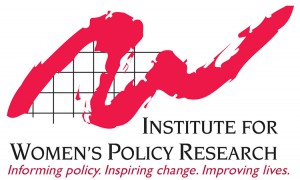Good, Growing, Middle-Skill Jobs Exclude Women, New Report Shows
To narrow the wage gap, women need greater access to well-paying jobs in key growth sectors
Washington, D.C., March 24, 2016 —Women account for only a third of positions in growing, middle-skill jobs that pay at least $35,000 or as much as $102,000 per year, according to a new report by the Institute for Women’s Policy Research (IWPR). These middle-skill jobs, which require a high school education but not a college degree, pay a living wage and can serve as a stepping stone to a lifelong career for women workers, who now serve as the sole or co-breadwinner in half of American families.
The report, supported by the JPMorgan Chase as part of its $250 million, five-year New Skills at Work initiative, analyzes jobs in the key growth sectors of manufacturing, information technology, and transportation, distribution, and logistics (TDL), and compares the skills required for various lower-paid, female-dominated jobs to those required for higher paying, male-dominated occupations. As companies throughout the United States face a skills shortage, the report identifies potential “on-ramp” occupations for women that will enable them to develop their existing skills to move into jobs in these growing sectors.
“Progress on closing the gender wage gap has slowed to a halt in the last decade,” said Ariane Hegewisch, IWPR Program Director for Employment & Earnings and lead author of the study. “At the same time, employers are facing a shortage in workers who can fill these fast growing jobs in middle-skill sectors. Integrating these occupations is a win-win-win for women, employers and the economy as a whole.”
Women’s earnings are essential to family economic security and broader economic growth, yet women still face a persistent gender wage gap, over half of which is due to occupational and industry segregation, where women work in lower paid jobs, typically done by women, and men work in higher paying jobs typically done by men. Women are also more likely than men to have completed high school, have some post-secondary college qualifications and to have a 2- or 4-year degree. This highlights that not only are women lacking opportunities to build careers that can support their families, but American companies may be missing out on a skilled, educated workforce that can drive economic success.
“With some of the most important sectors in the U.S. economy lacking enough skilled workers to meet demand, there is an opportunity for women to enter into nontraditional roles that have traditionally been held by men,” said Chauncy Lennon, Head of Workforce Initiatives, JPMorgan Chase. “Increasing access to additional skills training for women would go a long way in tackling their underrepresentation in good manufacturing, IT and transportation jobs.”
The report finds a startling lack of women in good middle-skill occupations in each key growth sector:
- In manufacturing, there will be 533,000 good jobs available over the next decade. Currently, only 7 percent of workers in these jobs are women.
- In information technology, there will be 240,000 good jobs available over the next decade. Currently only 29 percent of workers in these jobs are women.
- In transportation, distribution, and logistics, there will be 1.3 million good jobs available over the next decade. Currently, only 9 percent of workers in these jobs are women.
Using an innovative analysis of government occupational data, the report seeks to identify potential talent pipelines to help women move into these good jobs. IWPR researchers compared over 252 job characteristics—including training requirements, on-the-job tasks, and the attitudes, experiences and attributes of workers—the report identifies middle-skill, female-dominated occupations that can serve as “on-ramps” to male-dominated target jobs facing skills shortages. The analysis revealed:
- Many women work in jobs that already have a similar skill profile to better paying, male-dominated jobs. In fact, if 10 percent of women workers entered similar but higher paying male-dominated jobs, the median earnings for these women would increase by over 50 percent, and for all women workers by 5 percent.
- Female packaging and filling machine operators could increase their earnings by over 50 percent by becoming welders. Women make up 56 percent of packaging and filling machine operators. Similar to welders, the job requires arm-hand steadiness, manual dexterity, and control precision. With additional certified training, these women may have success in this higher-paying career path. Median annual earnings for welders are $38,762, which is 50 percent higher than earnings for packaging and filling machine operators at $25,851 per year.
- Library assistants—8 in 10 of whom are women—get paid almost $24,000 less per year than IT support specialists, nearly 3 in 4 of whom are men. Based on the analysis, these two occupations share many similar characteristics, and with some additional training and education, library assistants could become IT support specialists, improving their own earnings and filling growing demand for IT workers.
The report concludes with recommendations for employers, policymakers, and workforce developers to create more gender-inclusive environments that successfully retain female talent. IWPR also launched an accompanying interactive website, womenandgoodjobs.org, which provides a searchable database of middle-skills jobs, allowing users to see the relationship between lower and higher paid middle-skill occupations and identify the opportunities for on-ramping women workers into better jobs.

The Institute for Women’s Policy Research (IWPR) is a 501(c)(3) tax-exempt organization that conducts rigorous research and disseminates its findings to address the needs of women and their families, promote public dialogue, and strengthen communities and societies.
![]()
JPMorgan Chase & Co. (NYSE: JPM) is a leading global financial services firm with assets of $2.4 trillion and operations worldwide. The Firm is a leader in investment banking, financial services for consumers and small businesses, commercial banking, financial transaction processing, and asset management. A component of the Dow Jones Industrial Average, JPMorgan Chase & Co. serves millions of consumers in the United States and many of the world’s most prominent corporate, institutional and government clients under its J.P. Morgan and Chase brands. Information about JPMorgan Chase & Co. is available at www.jpmorganchase.com.
